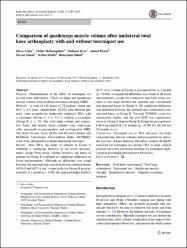Comparison of quadriceps muscle volume after unilateral total knee arthroplasty with and without tourniquet use

View/
Access
info:eu-repo/semantics/openAccessDate
2016Author
Güler, OlcayMahiroğulları, Mahir
İşyar, Mehmet
Pişkin, Ahmet
Yalçın, Sercan
Mutlu, Serhat
Şahin, Bünyamin
Metadata
Show full item recordCitation
Güler, O., Mahiroğulları, M., İşyar, M., Pişkin, A., Yalçın, S., Mutlu, S. ... Şahin, B. (2016). Comparison of quadriceps muscle volume after unilateral total knee arthroplasty with and without tourniquet use. Knee Surgery Sports Traumatology Arthroscopy, 24(8), 2595-2605. https://dx.doi.org/10.1007/s00167-015-3872-5Abstract
Determination of the effect of tourniquet use in total knee arthroplasty (TKA) on thigh and quadriceps muscle volume using magnetic resonance imaging (MRI). A total of 148 knees of 74 patients (mean age 66.5 +/- 4.8 years; female/male, 62/12) with bilateral primary varus gonarthrosis underwent unilateral TKA with a tourniquet (Group A, n = 35) or without a tourniquet (Group B, n = 39). The total thigh volume and connective, bone, and muscle tissue volumes were stereologically measured on preoperative and postoperative MRI. The Knee Society Score (KSS) and Western Ontario and McMaster Universities Osteoarthritis Index (WOMAC) score were calculated to evaluate functional outcomes. After TKA, the knees of patients in Group A exhibited a significant decrease in all tissue measurements, except bone tissue volume; however, the knees of patients in Group B exhibited no significant difference in tissue measurements. Although no difference was found between the operated and contralateral non-operated thighs (4076.9 and 4073.4 cm(3), respectively) in Group B postoperatively at 1 month (p > 0.05), the operated thighs had lost 20 % of its volume in Group A postoperatively at 1 month (p < 0.001). A significant difference was found in all tissue measurements, except the connective and bone tissue volumes of the thigh between the operated and contralateral non-operated knees in Group A. No significant difference was identified between the operated and contralateral non-operated knees in Group B. The total WOMAC score was significantly higher, and the total KSS was significantly lower in Group A than in Group B during the postoperative follow-up period of 1-6 months (p < 0.001 for all) but not 12 months (n.s.). Tourniquet use in TKA decreases the thigh and quadriceps muscle volumes and postoperatively delays the recovery of knee function. Therefore, caution should be exercised for tourniquet use during TKA in daily clinical practice and using alternative methods for tourniquet application in preventing intraoperative blood loss. III.
WoS Q Kategorisi
Q1xmlui.dri2xhtml.METS-1.0.item-scopusquality
Q1Source
Knee Surgery Sports Traumatology ArthroscopyVolume
24Issue
8Collections
- Makale Koleksiyonu [3790]
- PubMed İndeksli Yayınlar Koleksiyonu [4251]
- Scopus İndeksli Yayınlar Koleksiyonu [6601]
- WoS İndeksli Yayınlar Koleksiyonu [6677]

















